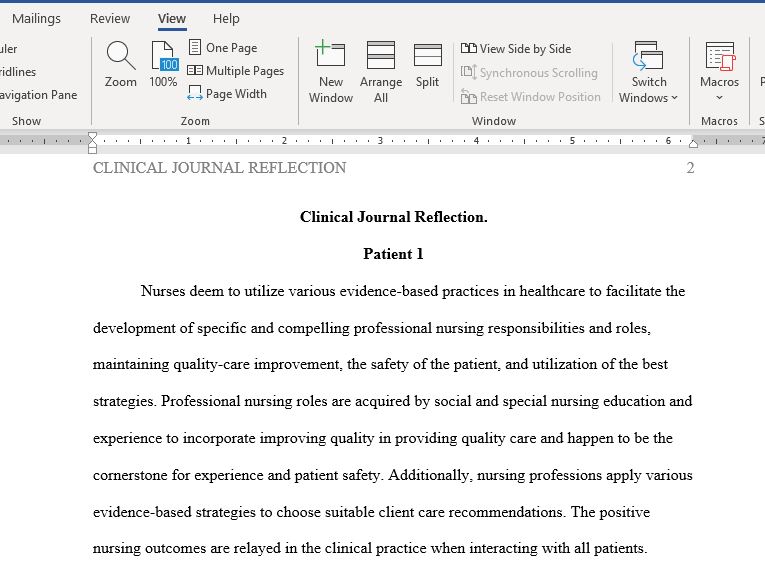Clinical Journal Reflection
Clinical journal reflection patient information
Patient 1
72 years old male with known medical comorbidities of hypertension, presented to the hospital secondary to recurrent fall and worsening mental status. He is confused and information is obtained from his wife. Has not seeing the doctor for the past 2 years. Lab: troponin elevation of 0.086, WBC: 12.6 with left shift. Negative CT angiogram. Vital sign: T 37.3 oc , HR 78, RR 18, BP 156/75 SPO2 100%, WT 160 kg, patient on room air, no pain. Ongoing problem: morbid obesity laying in bed, not oriented to place and time. Medication: Vancomycin, potassium chloride, heparin, lasix, amlodipine.
Nursing interventions: assist the patient with ADLs, administer medication, reposition the patient
How can we use evidence-based practice to care for this patient?
This introduction was validated by instructor, you can used it or do another one.
Nurses seek to utilize evidence-based practice to promote the development of professional nursing roles, ensure quality improvement, client safety, and application of best practices. Professional nursing roles are gained through education and experience to ensure they participate in improving quality in care provision, which is the foundation for client safety and experience. Additionally, nurses use evidence-based practice to apply the best interventions in patient care. The outcome is reflected in clinical practice when dealing with patients. According to Oldland et al. (2020), professional nursing roles include promoting patient safety, using evidence-based practice, professional competence, clinical leadership, and promoting patient-centric care. Additionally, EBP and quality improvement are core competencies that promote patient quality.
Patient 2
56 years old male, coming from the nursing home, tracheostomy dependent, non verbal, sleeping the whole time and is able to cough. He has 2 central line, one for dialysis and other for medication, he has Gastrointestinal tube feeding and foley catheter. Has a history of stroke, pneumonia and UTI. He came in because of abnormal lab value: WBC 12000, Hgb 6.7, BUN 151 patchy airspace opacities notes reveal that the right greater than left lower lobe which may reflect atelectasis, he has blister on his left hand, wound, bedsore. Vital signs: temperature 38.5 oc, BP; 140/88, RR 18, SPO2 98 HR 60. 157 kg. Medication: vancomycin, pantoprazole, zosyn, enoxaparin, acetaminophen.
Nursing interventions: administered medications through the picc line, draw blood, feet the patient
through the Gtube. I think , caring behavior is good for this one. How can we use caring behaviors to care
for a unconscious(intubate) patient.
Patient 3
57 years old female found by the police at the parking lot near the car. Chief complaint is substance abuse, report drinking since she 17 years old, 4 to 6 bottles of mini jack, smoker, cannabis sometime, hypokalemia(2.5). Three family members die Mom from Alzheimer, Dad, and ex-husband. She is taking care of her son that has schizophrenia. She reports recurrent depression episode such as sadness, crying, low energy, loss of interest, loss of motivation, helplessness, suicidal thought denied. History of hypertension, arthritis. She is alert and oriented. Vital signs: temperature 36.8 HR 70 RR 20 BP 162/71 SPO2 97% wt. 70kg aching pain on her lower left leg related to arthritis 7 out of 10. Medication: enoxaparin, folic acid, vit B1, multi vit, Buspirone, losartan, citalopram, amlodipine, tramadol Nursing interventions: ADLs, medications, therapeutic communication(remind her that God is always there for everyone, church, social service, encourage to take care of herself, …) How can we use therapeutic communication to care for this patient?
Patient 4
History of Present Illness Patient is a 62 years old male with past medical history significant for hypertension and gout who presented emergency room with 2 days of vertigo nausea and emesis. He reports associated blurry vision but no double vision . Patient reports no oral intake over the last 2 days due to ongoing emesis and dizziness. He has not tried any medication at home and presented to ED today because of worsening of his symptoms. He denies any other neurological deficits and denies headaches. Patient denies any prior history of CVA. Patient denies any chest pain or shortness of breath. No palpitation dizziness or LOC. He is compliant with his BP regimen.
Nursing interventions: head to toe assessment, administer medication, educate about side effect of
the medication, educate about lifestyle change to improve health, and so on
Choose the nursing concept that applied to this and write the clinical journal reflection about it.
Answer Preview For Clinical Journal Reflection
Access the full answer containing 1168 words by clicking the below purchase button

